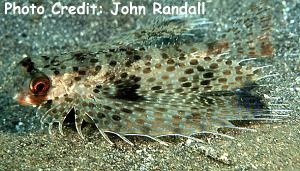
By Bob Goemans


Not Reef Tank Suitable
Likely Fish-Only Tank Suitable
These fishes belong in the Order Scorpaeniformes and Suborder Dactylopteroidei as members of the Family Dactylopteridae (Helmut Gurnards) consisting of 2 genera, Dactyloptena and Dactylopterus (Flying Gurnards), totaling 7 species.
These fishes have large pectoral fins that render a somewhat wing-like structure. Those in the genus Dactylopterus are capable of gaining enough speed to break the surface of the water and glide short distances in the air and are called Flying Gurnards. They are rarely collected. Those in the genus Dactyloptena are not capable of this maneuver as their wings are less flexible and are slow moving spending the majority of their time on bottom areas searching for meaty foods. They occasionally show up in the trade.
Their wings, in fact, are used for walking forward and backward on bottom areas where its first three rays are finger-like and are used to comb the substrate in search of foodstuffs. They have large mouths and will feed upon crabs, shrimp, small bivalves, amphipods, and small fish, especially those sleeping during night hours when gurnards are normally more active.
When disturbed, they spread their so-called wings in an effort to look larger, hoping to ward off predators and can also produce audible grunts.
They are not suitable for most aquariums, as they need lots of open bottom areas to traverse; therefore, live rock or other decor needs to be kept at a minimum. Also, small fishes/shrimp in the aquarium would be considered a meal. And since these fish become easily agitated and may injure themselves swimming into aquarium side panels or other decor, they need unencumbered and peaceful environments, and usually nothing less than a 75-gallon aquarium with a fine sand substrate.
For in-depth information concerning these fishes, checkout Reef Fishes Volume 1 by Scott Michael (ISBN #1-890087-21-1). You can see a review of this exquisite book by visiting my Product & Book Reviews page.